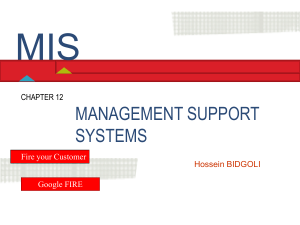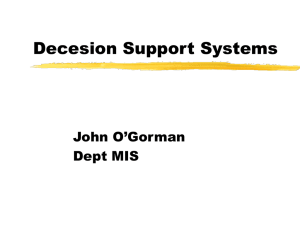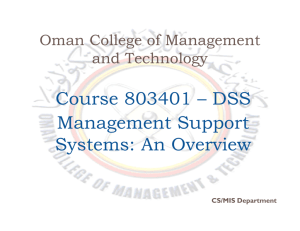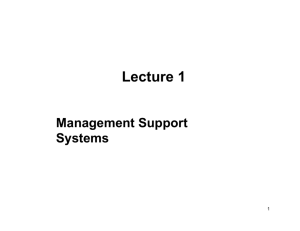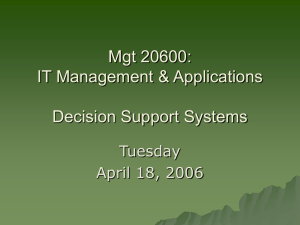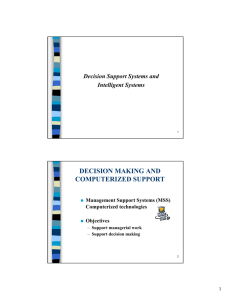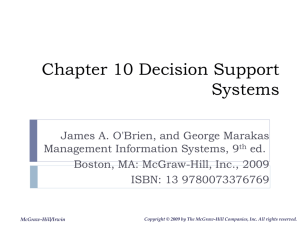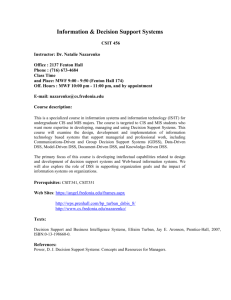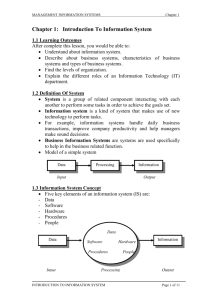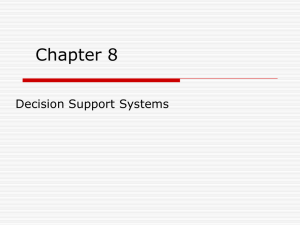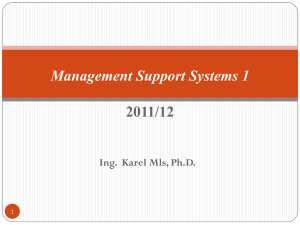Chapter 12 Management Support Systems
advertisement
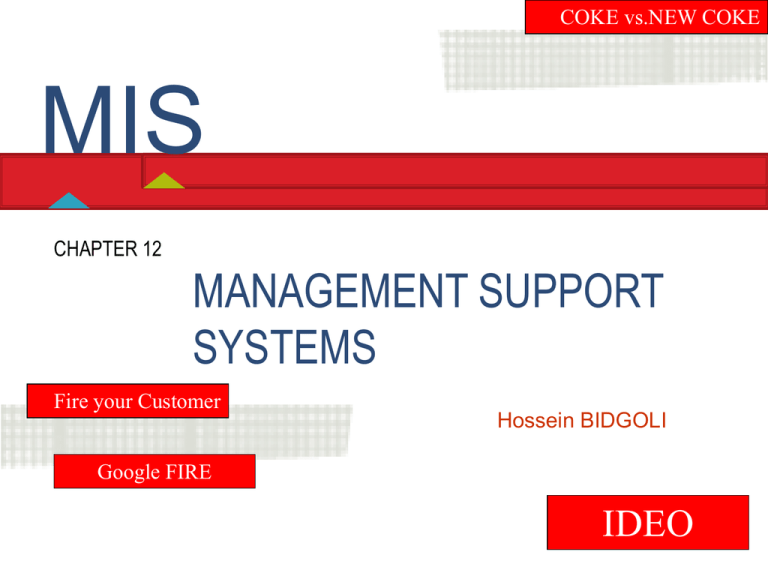
COKE vs.NEW COKE MIS CHAPTER 12 MANAGEMENT SUPPORT SYSTEMS Fire your Customer Hossein BIDGOLI Google FIRE IDEO Fire your Customer They make decisions Better decisions = better managers The amount of information people must understand to make decisions, solve problems, and find opportunities is growing exponentially 2 Structured decisions ◦ Well-defined standard operating procedure exists ◦ Also called programmable tasks ◦ Can be automated Semistructured decisions ◦ Not as well-defined by standard operating procedures ◦ Include a structured aspect that benefits from information retrieval, analytical models, and information systems technology Unstructured decisions ◦ Unique; typically one-time decisions ◦ Does not rely on standard operating procedure ◦ Decision maker’s intuition plays the most important role ◦ Information technology offers little support for these decisions Management support systems (MSSs) ◦ Different types of information systems have been developed to support certain aspects and types of decisions COKE vs.NEW COKE • Structured – How many workers to staff line A – What is the EOQ for raw material Z – How many turbines to power Lethbridge? • Unstructured – What are the benefits of merging with XYZ – How will consumer react if we lower the price by 10% – What are the benefits of MacDonald's opening up Hotels 5 Herbert Simon ◦ Winner of the 1978 Nobel Prize in economics ◦ Defines three phases in the decision-making process: intelligence, design, choice ◦ Fourth phase, implementation, can be added Problem budget Criteria or objectives ( intelligence) – 1 2 Alternatives 1 2 3 4 5 (design) raise tuitiion fees cut wages fund raise increase classes How to cut $12 milliion or 7% from (design) Organization devises a plan for carrying out the alternative selected in the choice phase Obtains the resources to implement the plan DSS can do a follow-up assessment on how well a solution is performing Decision support system (DSS) ◦ Interactive information system ◦ Consisting of hardware, software, data, and models (mathematical and statistical) ◦ Designed to assist decision makers in an organization Requirements: ◦ Be interactive ◦ Incorporate the human element as well as hardware and software ◦ Use both internal and external data ◦ Include mathematical and statistical models ◦ Support decision makers at all organizational levels ◦ Emphasize semistructured and unstructured tasks What-if analysis Goal-seeking Sensitivity analysis Exception reporting analysis More capabilities, such as: ◦ “ If the advertising budget increases by 2 percent, what’s the effect on total sales?” ◦ how much to advertise a product to increase total sales to $ 50,000,000. ◦ how much the interest rate has to go down for you to be able to afford a $ 100,000 house with a monthly payment of $ 700. ◦ such as pinpointing the region that generated the highest total sales ◦ Graphical analysis, forecasting, simulation, statistical analysis, and modeling analysis Benefits of a DSS: ◦ ◦ ◦ ◦ ◦ ◦ ◦ ◦ Increase in the number of alternatives examined Fast response to unexpected situations Ability to make one-of-a-kind decisions Cost savings Better decisions More effective teamwork Time savings Making better use of data resources Interactive information systems that give executives easy access to internal and external data Typically include: ◦ “Drill-down” features ◦ Digital dashboard Ease of use ◦ EIS designers should focus on simplicity when developing a user interface Require access to both internal and external data ◦ So that executives can spot trends, make forecasts, and conduct different types of analyses Should also collect data related to an organization’s “critical success factors” EIS increases managers’ productivity EIS can convert information into other formats EIS can spot trends and report exceptions Assist groups in: Intended more for teamwork than for decision support ◦ Communicating, collaborating, and coordinating their activities Use computer and communication technologies to formulate, process, and implement a decision-making task Useful for: ◦ ◦ ◦ ◦ ◦ Committees Review panels Board meetings Task forces Decision-making sessions that require input from several decision makers Some capabilities of groupware include: ◦ ◦ ◦ ◦ ◦ ◦ ◦ ◦ ◦ Audio and video conferencing Automated appointment books Brainstorming Database access E-mail Online chat Scheduling To-do lists Workflow automation Advantages: ◦ Costs as well as stress are reduced due to decreased travel ◦ More time to talk with each other and solve problems ◦ Shyness isn’t as much of an issue in GSS sessions ◦ Increasing collaboration improves the effectiveness of decision makers Disadvantages: ◦ ◦ ◦ ◦ Lack of the human touch Unnecessary meetings Security problems Costs of GSS implementation are high Captures, stores, processes, and displays geographic information Uses spatial and nonspatial data Common example of a GIS: ◦ Getting driving directions from Google Maps ◦ User-friendly interface that helps you visualize the route ◦ After you make a decision, you can print driving directions and a map Google FIRE IDEO Different types of decisions Phases of decision making in a typical organization DSS: ◦ Components, capabilities, key players, and costs and benefits Executive information systems Group support systems Geographic information systems
